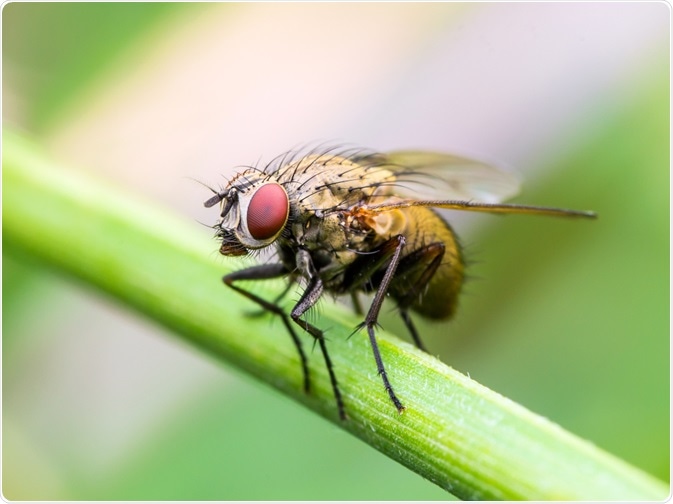Morphogens are signaling molecules that are released from particular areas of tissues, creating a concentration gradient that decreases in concentration further away from the source. This has implications for development, where cell and tissue differentiation is linked to the concentration of morphogens in the environment.
In one study, genetic mutations linked to congenital heart defects were shown to elevate the signaling of the Hedgehog morphogen family in mice, which then led to heart defects.
.jpg) Bone morphogenetic protein 7 (BMP-7) is a morphogen that plays an important role in development of bone and cartilage. Image Credit: StudioMolekuul / Shutterstock.com
Bone morphogenetic protein 7 (BMP-7) is a morphogen that plays an important role in development of bone and cartilage. Image Credit: StudioMolekuul / Shutterstock.com
What are morphogens?
Morphogens are signaling molecules that have direct action on cells. The activity of morphogens induces changes in the cells, which differ according to how much morphogen the cell has been exposed to. These signaling molecules are released from specific regions of tissues, meaning that the concentration of morphogens is higher close to the source. Hence, the cells near the morphogen source will change in a different manner to those further away. Morphogens are key in animal development.
There are several known families of morphogens; these include Hedgehog, Wnt and TGFß. The Hedgehog family was first identified in Drosophila, when a mutant embryo developed hair-like structures. Further studies revealed that Hedgehog is a protein that is capable of influencing pattern development in nearby cells. Then, similar proteins were found in mammals, including Sonic hedgehog, Indian hedgehog and desert hedgehog.
Mapping Morphogen Signaling Pathways
These were shown to be evolutionarily conserved, and thus they established the role of organizer tissues and morphogens in development. In fact, congenital syndromes like holoprosencephaly have been linked to a dysregulation of Hedgehog signaling and a study by Kong et al. showed that two genetic mutations linked to congenital heart defects were due to elevated Hedgehog signaling in a mouse model.
PCT is the first receptor that was identified as being a target for Hedgehog. This is a transmembrane protein, and before Hedgehog binds it, it represses another receptor, Smoothened. When Hedgehog binds to PCT, this repression is stopped and Smoothened is able to act via a signaling pathway to activate GLI family zinc finger proteins. This is the main way in which gene expression is controlled by Hedgehog.
How do morphogens affect animal development?
The effect of morphogens on development has been shown in various animals. This includes Sonic hedgehog during chick neural tube development; Sonic hedgehog spreads from the notochord, which then causes the floor plate to be formed. The floor plate then produces Sonic hedgehog, which creates a Sonic hedgehog activity gradient which is ventral-dorsal.
Another example is Squint in early embryonic zebrafish development; this TGFß morphogen is thought to be involved in the formation of the mesoderm and endoderm in the developing embryo.
Morphogens and Drosophila wing development
The most studied example of morphogens and their effect on development is in Drosophila. There are various morphogens that have been shown to be involved in the development of appendages in Drosophila.
As mentioned previously, Hedgehog was first identified in Drosophila. It is a short-range morphogen and plays a role in the development of wings. The wings develop from the imaginal wing disc in the larvae, which is divided into the anterior and posterior compartments.
Hedgehog is produced in the posterior compartment and then secreted into the anterior compartment when the gene en is expressed. In the anterior compartment, Hedgehog causes a change in gene expression, such as induction of patched, en and dpp, forming the pattern in the central part of the wing.
Dpp is a TGFß family morphogen and is classed as a long-range morphogen. Dpp has been shown to pattern the wing outside the central part. Dpp is produced along the margin between the posterior and anterior region of the imaginal wing discs and induces the expression of genes including sal and omb.
Once the anterior-posterior compartments are formed in the imaginal wing discs, the next stage involves the formation of the dorsal and ventral compartments. The expression of fringe is induced in the dorsal compartment by Apterous, which activates the Notch receptor pathway along the margin between the dorsal and ventral compartments. The activation of Notch then induces the expression of Wg, a Wnt family morphogen, which causes the expression of genes including achaete, Distal-less and vestigial, causing further patterning of the wing.
 The Hedgehog family was first identified in the model organism Drosophila melanogaster, when a mutant embryo developed hair-like structures. Image Credit: nechaevkon / Shutterstock.com
The Hedgehog family was first identified in the model organism Drosophila melanogaster, when a mutant embryo developed hair-like structures. Image Credit: nechaevkon / Shutterstock.com
Hedgehog and the heart
Congenital heart defects are one of the most commonly seen birth defects, however it is still unclear how they occur due to their complex genetics. Certain genes have been implicated in the development of congenital heart defects, including Megf8 and Mgrn1. Kong et al. used a mouse model to investigate the effect of mutations in Megf8 and Mgrn1 on heart development.
MEGF8 is a transmembrane protein and MGRN1 is an E3 ligase belonging to the RING superfamily. These two proteins combine into a receptor-like ubiquitin ligase complex, which is involved in the ubiquitination and degradation of proteins including Smoothened, a protein involved in the Hedgehog signaling pathway.
Mutation in Megf8 and Mgrn1 led to an increase in Smoothened, as well as an increase in sensitivity to Hedgehog signaling. The consequence in the mouse model was heterotaxy in the embryo, which could be an indication of a congenital heart defect.
Sources
- Tabata, T. and Takei, Y. (2004) Morphogens, their identification and regulation Primer doi: 10.1242/dev.01043
- Briscoe, J. and Thérond, P. P (2013) The mechanisms of Hedgehog signalling and its roles in development and disease Nature Reviews Molecular Cell Biology https://doi.org/10.1038/nrm3598
- Kong, J. H. et al. (2020) A Membrane-Tethered Ubiquitination Pathway Regulates Hedgehog Signaling and Heart Development Developmental Cell https://doi.org/10.1016/j.devcel.2020.08.012
Further Reading
- All Embryonic Development Content
- What is Gastrulation?
- What is Somitogenesis?
- The Stages of Early Embryonic Development
Last Updated: Jan 25, 2021

Written by
Dr. Maho Yokoyama
Dr. Maho Yokoyama is a researcher and science writer. She was awarded her Ph.D. from the University of Bath, UK, following a thesis in the field of Microbiology, where she applied functional genomics toStaphylococcus aureus . During her doctoral studies, Maho collaborated with other academics on several papers and even published some of her own work in peer-reviewed scientific journals. She also presented her work at academic conferences around the world.
Source: Read Full Article
